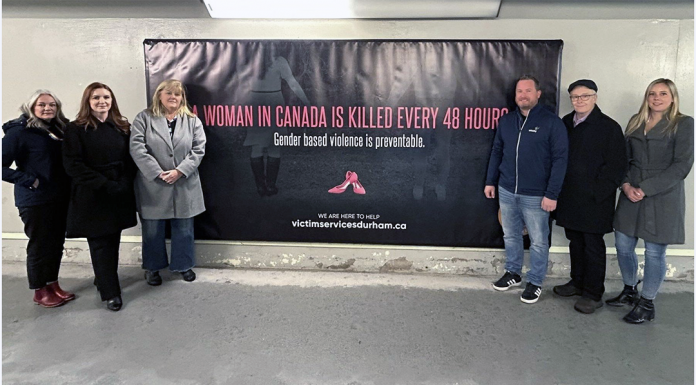Content warning: This article discusses gender-based violence, including references to sexual and physical abuse, trauma and death. Reader discretion is advised.
Victim Services of Durham Region (VSDR) recently released an article stating that, compared to last year, the number of victims experiencing gender-based violence (GBV) crimes has increased by 25 per cent.
Gender-based violence refers to harmful acts directed at individuals based on their gender, often rooted in power imbalances, social norms and inequality.
In a research study written by the Canadian Femicide Observatory for Justice and Accountability, in 2022, 184 women and girls were violently killed, primarily by men. That meant one woman or girl was being killed every 48 hours.
This year alone, the VSDR has supported more than 5,600 victims subjected to GBV, a notable increase from the 5,400 cases they dealt with the previous fiscal year.
History and research have demonstrated that GBV is primarily rooted in gender inequality and the abuse of power, arising from harmful social norms, patriarchal structures and unequal power relations between genders.
Krista MacNeil, executive director of Victim Services Durham Region (VSDR), explains that analyzing GBV involves categorizing different forms of abuse. Data gathered from Durham Region has helped identify the most prevalent types.
“The three main ones that we capture in terms of our statistics that victim services would be human trafficking, sexual violence and intimate partner violence,” said MacNeil. “ But even within those three major types, you can break it down further.”
MacNeil explained that the power imbalance between men and women and the issue of gender equality were not discussed, nor reported on, as much as they are today. However, despite the progress society has made in terms of women’s rights, acts of gender inequity persist, and the remnants of those inequities lead to GBV.
Even if the victim manages to leave their abuser, the aftermath of dealing with the trauma inflicted on them can continue to impact every aspect of their life. MacNeil described numerous situations where the effects of gender violence influence a victim’s self-esteem and confidence, often making them hesitant to open up to others out of fear that they won’t be believed.
Adding on to this, gender-based violence expert and advocate Riley Spigarelli wrote in an email how false reports of sexual assault are rare and being dismissive can be harmful to a victim and their ability to move forward and find the proper help they need.
“Experiencing trauma impacts our brain, memory and our ability to recount every detail clearly,” said Spigarelli. “The human memory on a good day isn’t perfect, let alone when you’ve experienced significant trauma.”
GBV can leave its victims feeling isolated and helpless in their situation. However, organizations like VSDR continue to collaborate with community agencies to provide trauma-informed support and advocacy for people in Durham who have experienced abuse or sudden tragedy.
Another option for someone facing abuse is to contact the Bethesda House, which, as explained by Spigarelli, provides assistance to women experiencing any form of gender-based violence and offers a safe emergency shelter.
“Bethesda House is just one part of the continuum of services available in Durham Region,” said Spigarelli. “There are emergency shelters, counselling, housing, legal, immigration, financial and employment support, and much more available to survivors of gender-based violence.”
For students who have trouble acquiring assistance in Durham Region, schools often have their own offices dedicated to providing help to students who are dealing with trauma or abuse.
Students at Durham College have access to a range of support systems and resources if they experience gender-based violence. The Office of Equity, Diversity and Inclusion offers accommodations based on individual needs while being mindful of the details they disclose. For more information, students can also access the college’s policy and procedure, as well as the Sexual Violence and Harassment Action Plan Annual Report.
At times, it can be challenging to recognize the signs when someone is experiencing abuse. MacNeil emphasized that education can play a crucial role in combating gender-based violence and in helping our youth become more informed about issues concerning healthy relationships, consent and gender inequality.
“It needs to be an ongoing conversation in the curriculum,” said MacNeil, emphasizing the importance of incorporating these topics into schools to help broaden students’ understanding of consent and safety.
MacNeil noted that while schools are making efforts, increased awareness and reporting make it more important than ever to ensure education on these issues is comprehensive and consistent.
“ We all need that to thrive as humans, and we know that the kids who are most likely to be impacted by violence and victimization are the kids who are not going to learn those things at home.”
One in three women will experience violence in their lifetime. MacNeil emphasized the importance of educating yourself on these issues so that, when someone comes forward with concerns about their own or someone else’s well-being, you can offer validation and provide them with the information needed to connect with the proper support.
“We need people to not just learn about what resources are available, but to go a little bit further and learn more about what that means,” said MacNeil. “ I would argue for that reason that every single person needs to be aware of these services and needs to be educated on the issue.”




